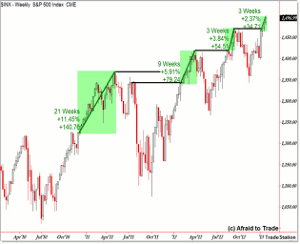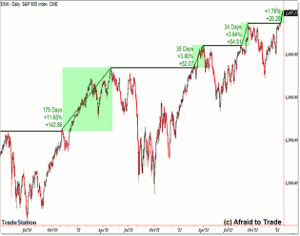As 75% of the 134 companies in the S&P 500 released earnings that beat analyst expectations coupled and an unexpected drop in jobless claims fueled the index to new heights, technician Corey Rosenbloom of AfraidToTrade.com looks to similar circumstances in the past for clues on what might come next.
With the S&P 500 recently breaking to new recovery highs above 1,474 and continuing unopposed to the initial 1,500 target, I thought it would be a good exercise to chart prior S&P 500 breakouts to new recovery highs and look at the outcome of these events.
Starting with the 2011 breakout above 1,220, there have been four similar breakouts as seen on the weekly chart:
I connected the breakout high to the absolute price high of the rally in an attempt to compare price movement and time elapsed during the sustained breakout phase.
There’s actually a few ways you can create these comparisons, as we’ll see from the daily chart below.
We’ll focus on the daily chart for the better comparison of recent breakout events and outcomes:
Notice the different ways I drew the trendlines:
On the weekly chart, I highlighted the sustained price movement that resulted from a breakout of a prior important swing high while on the daily chart I used a stricter interpretation, which drew a trendline from the break above the prior swing high (which resulted in a new recovery high).
The difference is important:
In all instances EXCEPT the current breakthrough above 1,474, there was at least a one-week pullback/retracement AFTER the S&P 500 ticked to a new recovery high.
I’ll use the daily chart for the sake of comparison.
The “first” breakout to new highs occurred on November 5, 2010, but it resulted in an immediate bull trap sudden 50 point retracement from the new recovery high.
Similarly, the second breakout event occurred on February 27, 2012, and resulted immediately in another bull trap retracement of 37 points.
The third “breakout” took place on August 21, 2012, with a spike reversal candle (trap) that resulted in a 27 point retracement.
In all three cases, price resumed the uptrend and sustained the breakout with a “short-squeeze” fueled impulse to the next swing high.
Using the stricter rules of the daily chart, the first breakout (2010) lasted 175 days and traveled up 143 points (11.65%).
No other rally has matched this distance or time traveled—all other breakouts have actually been very similar.
February 2012’s breakout lasted 35 days and rallied 52 points (3.80%).
August 2012’s similar breakout took place over 24 days during a slightly larger 54 point (3.84%) rally.
Here’s where the comparisons are important—the current breakout (January 17, 2012 above 1,474) so far has lasted eight days during a sustained (day-over-day) 26 point (1.78%) rally.
It’s worth noting that the round number 1,500 area has been a short-term target that the index achieved yesterday, so if we see further continuation (another breakout) above 1,500, we could compare the current rally in terms of the prior two rallies which rose roughly 50 points.
From the breakout above 1,474, the index would target the 1,525 region.
Continue studying prior breakouts for additional insights and we’ll continue to assess the current “breakout to new recovery highs” in terms of the prior four instances listed above.
By Corey Rosenbloom, CMT, Trader and Blogger, AfraidToTrade.com












